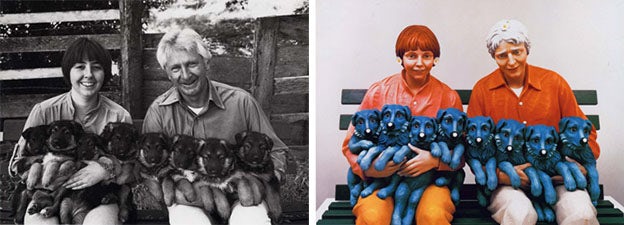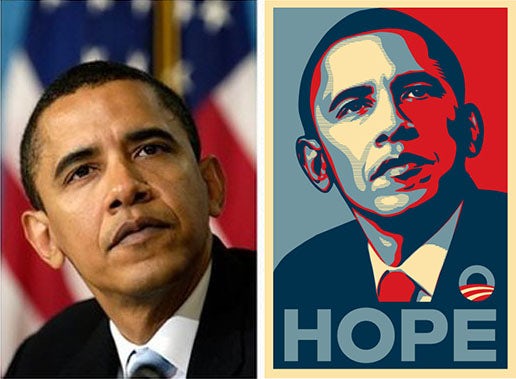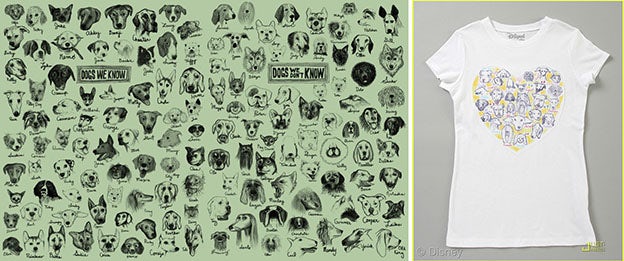Famous Cases

Case Rogers vs Koons
Photographer Art Rogers shot a photograph of a couple holding a line of puppies in a row and sold it for use in greeting cards and similar products. Internationally, renowned artist Jeff Koons used Rogers’ photograph to create a set of statues based on the image.
Koons sold several of statues at a significant profit. Upon discovering the copy, Rogers sued Koons for copyright. Koons responded by claiming fair use by parody.
Outcome
The court found the similarities between the 2 images too close, and that a “typical person” would be able to recognize the copy. Koon’s defense was rejected under the argument that he could have used a more generic source to make the same statement — without copying Rogers’ work. Koons was forced to pay a monetary settlement to Rogers.
This is one of those famous cases that encompassed a larger issue in the art world, the issue of appropriation art. Can you build upon another’s work to create your own original piece? And if you do so, does that constitute derivative work? Does creating a derivative work that subtracts value from the original artist?

Case Cariou vs. Prince
Richard Prince is a well known artist who transforms the work of others to create new meaning in his own work. For an exhibition in the Gagosian Gallery, Prince appropriated 41 images from a photography book by French photographer Patrick Cariou. Prince claimed fair use because he created new meaning out of the photographs. Cariou argued that it wasn’t fair use, but copyright infringement.
Outcome
A judge ruled in favor for Cariou in 2011, claiming the changes made to Cariou’s photographs weren’t significant enough to constitute a change in meaning. However, in 2013 the original decision in this case was overturned for all but 5 images and the judge ruled in favor of Prince for the majority of the works in dispute, claiming that Prince’s work transformed the work in the way that it was aesthetically different, and thus acceptable under the argument of fair use. The 5 images in dispute went back to the lower courts and the eventually that case was settled out of court.

Case Associated Press vs Fairey
Famous street artist Shephard Fairey created the Hope poster during President Obama’s first run for presidential election in 2008. While not an official campaign poster, it quickly became a symbol for the campaign.
The photograph on which Fairey based the design was one shot by AP freelancer Mannie Garcia.The AP demanded compensation for its use in Fairey’s work. Fairey responded with the defense of fair use, claiming his work didn’t reduce the value of the original photograph.
Outcome
The artist and the AP press came to a private settlement in January 2011, part of which included a split in the profits for the work.
Case Gaylord vs United States
Vermont artist Frank Gaylord created 19 unique sculptures installed to create a national memorial for veterans of the Korean War in 1995. in 2003 am image of the memorial was used as commemorative stamp with out the artists approval, and Gaylord sued the United States Post Office. Other memorials have been reproduced as stamps including Maya Linn's Vietnam War memorial.
Outcome
Production of the stamp was halted and in 2013, a federal court told the USPS that it owes Vermont sculptor Frank Gaylord $684,844.94 for the unauthorized use of his Korean War Veterans Memorial on a 2003 stamp.

Case Modern Dog vs Target/Disney
Seattle design firm Modern Dog utilized a series of sketches of dogs in their compendium put out by Chronicle Books in 2008. The firm alleges that illustrations from that design have been used in a T-shirt produced by Disney/Target for sale, and filed a lawsuit in 2011.
Outcome
In 2014 Modern Dog was awarded copyright over the image, and Target/Disney stopped selling the shirt. However, Modern Dog went into debt to pursue the lawsuit and had to resort to donations to fund their suit and sold their company in the end

Thaler vs United States Copyright
August 19, 2023, an appeal by Stephen Thaler, to overturn a previous copyright ruling, was denied. United States District Court Judge Beryl A. Howell ruled on Friday that AI-generated artwork can’t be copyrighted. Judge Howell didn’t see it that way. In her decision, Judge Howell wrote that copyright has never been granted to work that was “absent any guiding human hand,” adding that “human authorship is a bedrock requirement of copyright.” She wrote that this would create “challenging questions regarding how much human input is necessary” to copyright AI-created art. Thaler plans to appeal again. He has also filed suits with US Patent office that were also denied.
Getty Vs Stability AI
Getty Images claims that Stability AI copied photographs from its website and used over 12 million images and associated metadata to train Stable Diffusion, despite express terms of use on Getty’s website expressly prohibiting such uses. Getty Images argues that the output generated by Stable Diffusion often contains a modified version of Getty Images’ watermark. Stability AI may claim that training AI on copyright protected materials qualifies as a transformative purpose that weighs heavily in favor of fair use. The case is currently being argued in England.
Class-Action Lawsuit Against Stability AI, Midjourney, and DeviantArt
In January of 2023 a class action complaint was filed against defendants Stability AI Ltd. and Stability AI, Inc., Midjourney, Inc., and DeviantArt, Inc. Plaintiffs allege that their works were used without permission as input materials to train and develop various AI image generators. Plaintiffs point out that the defendants reap substantial profit on the value of these copyrighted images, highlighting that the defendants’ AI machines generate images “‘in the style’ of a particular artist are already sold on the internet, siphoning commissions from the artists themselves.” The complaint refers to Stable Diffusion as a “21st century collage tool.” However, collage artists make use of copyrighted material without authorization, the use may qualify as fair use.
